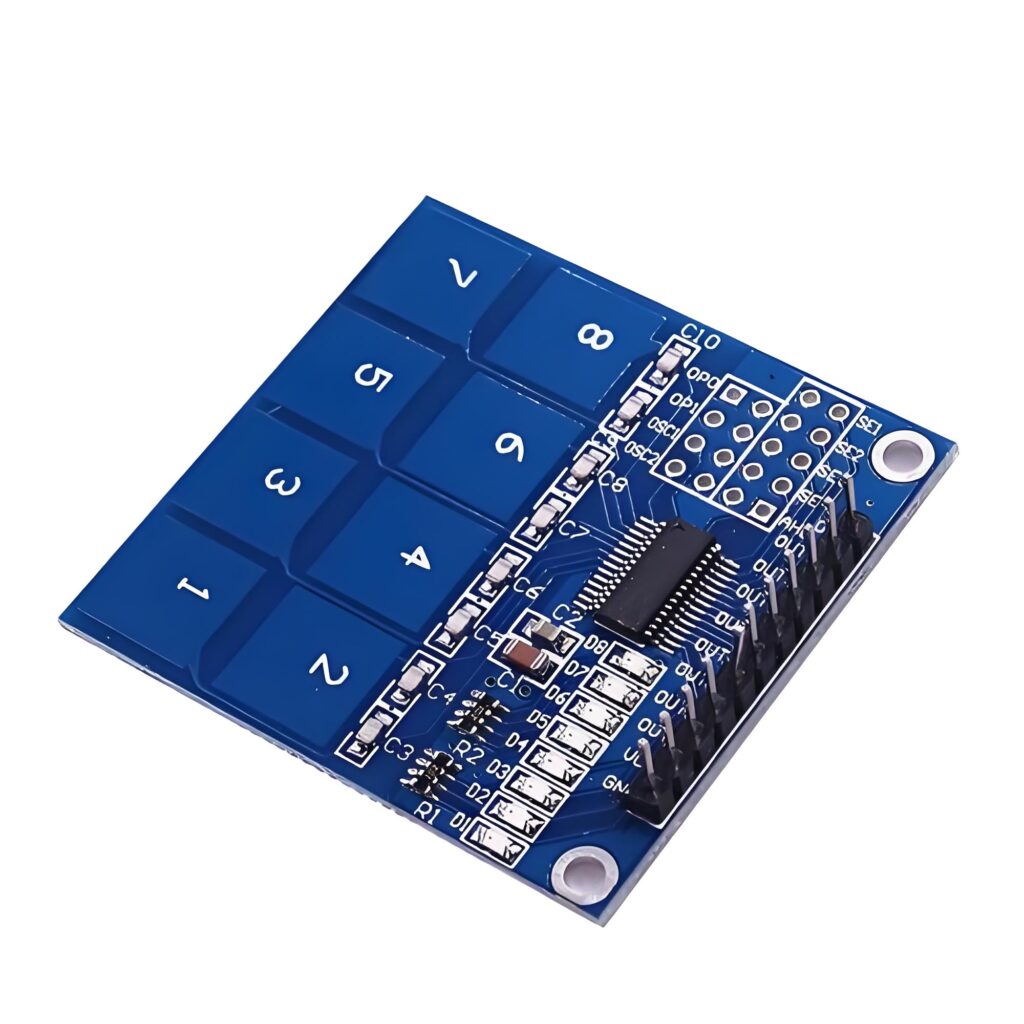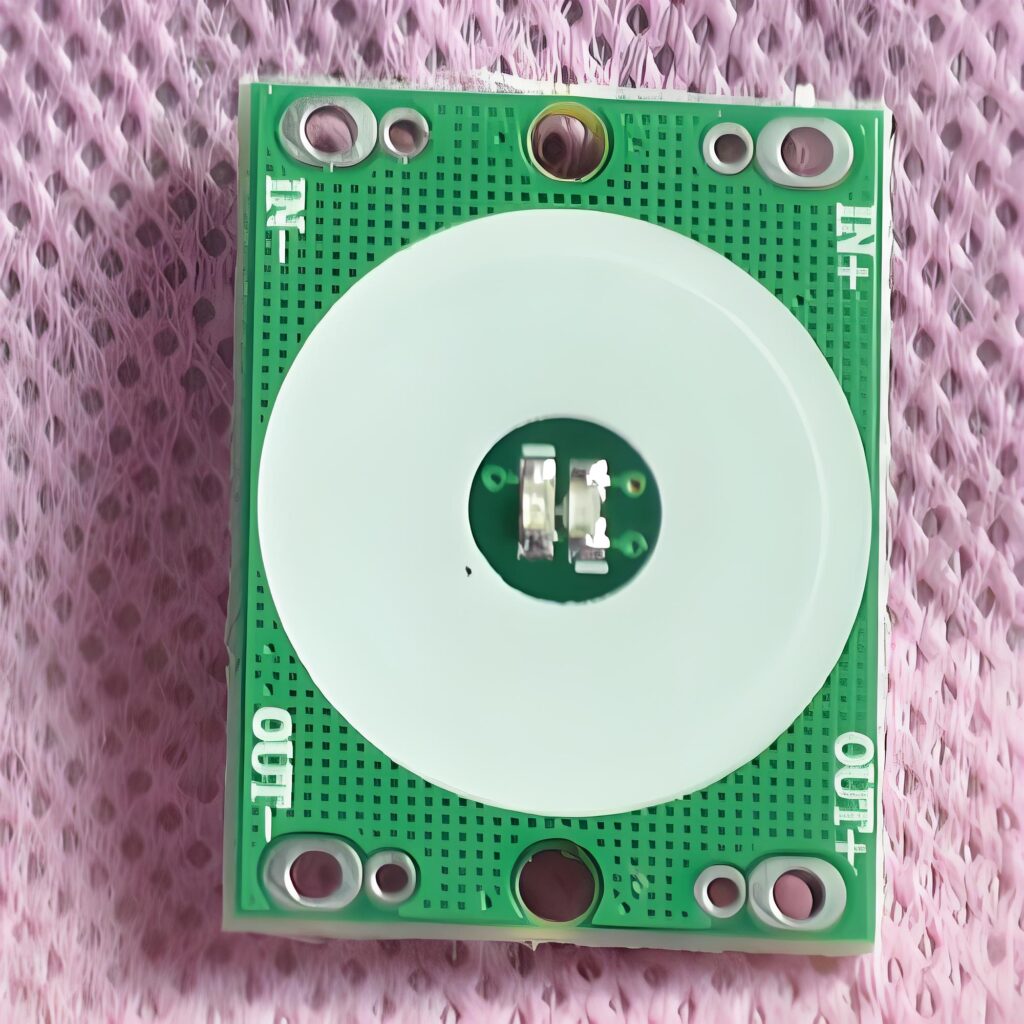A capacitive button is an input device that uses capacitance changes to detect touch operations. It usually consists of a sensing electrode and a control circuit. When a finger or other conductive object approaches or touches the sensing electrode, the electric field distribution around the electrode will change, causing a change in the capacitance value.
What are capacitive touch keys?
A capacitive touch key is an electronic component that implements touch operations through the principle of capacitive sensing. Its working principle is to identify touch actions by detecting the capacitance change between the human body and the touch panel.
When the human body approaches or touches the capacitive touch key, the human body, as a conductor, will change the electric field distribution on the touch panel, resulting in a capacitance change. This change is detected by the circuit inside the touch panel and converted into a corresponding electrical signal, which in turn triggers the corresponding operation.
Capacitive touch keys are widely used in various electronic devices, such as remote controls, lamp dimming, various switches, household appliances, and vehicle-mounted equipment.
Compared with traditional mechanical buttons, capacitive touch keys have the advantages of long life, easy operation, waterproofness, and strong anti-interference ability, and can provide a better user experience.
Advantages?
High sensitivity: can accurately detect the touch action of the finger.
Good stability: environmental changes or long-term use will not affect its performance.
High reliability: waterproof and strong anti-interference ability.
Strong adaptability: can work stably in various environments and adapt to a wide temperature range.
In summary, capacitive touch keys have been widely used in various electronic devices through their unique sensing principle and superior performance, and are favored for their high sensitivity, high stability and high reliability.
How do capacitive buttons work?
The working principle of capacitive buttons is as follows:
Formation of basic capacitance:
Under normal conditions, a tiny inductive capacitance is formed between the sensing plate in the capacitive button and the ground. Even if there is no touch operation, the value of this inductive capacitance is relatively fixed, but the value is usually very small.
The influence of human body capacitance:
When a human finger approaches or touches the sensing plate of a capacitive button, since the human body itself also has a certain capacitance, the inductive capacitance formed by the human finger and the ground will be connected in parallel to the capacitance between the original sensing plate and the ground.
This parallel effect causes the total inductive capacitance value to increase rapidly. The human body is like a conductor, which introduces its own capacitance into the circuit system of the button, changing the capacitance parameters in the circuit.
Circuit detection and signal conversion:
The control circuit of the capacitive button will continuously detect the capacitance value of the sensor plate. When the capacitance value is detected to have changed significantly (exceeding the preset threshold), the circuit will convert this capacitance change into an electrical signal.
Generally speaking, this electrical signal will be amplified by an amplifier for subsequent processing and judgment.
The processed electrical signal will be transmitted to the relevant control chip or processor. The chip will determine whether it is a valid touch operation according to the preset program and logic, and trigger the corresponding function or instruction accordingly.
In short, the capacitive button detects and responds to the touch operation based on the change of capacitance. This working mode makes the capacitive button have the advantages of high sensitivity, fast response speed, beautiful appearance and no need for mechanical structure.
Is capacitive touch good?
Capacitive buttons have many advantages, which make them widely used in modern electronic devices.
First of all, capacitive buttons have high sensitivity. It triggers the operation by sensing the current of the human body. The user only needs to touch lightly to realize the switch function, avoiding the disadvantage of traditional mechanical buttons that require greater force to press and reducing hand fatigue.
Secondly, the capacitive button has good sealing. Since there is no mechanical structure and contact, an integrated structure can be used in the design, reducing the risk of leakage and water ingress, so that it can maintain good durability and reliability even in harsh environments.
In addition, the appearance of the capacitive button is beautiful. Since its design does not require additional mechanical structure, designers can freely create various shapes and appearances, such as flat, round, prismatic, etc., and can add backlight or LED light design to increase the beauty and recognition of the product.
The life of the capacitive button is long. Since its contact part operates based on the non-contact principle, there is no contact wear and friction, and it is not easy to have problems such as poor contact and oxidation.
At the same time, due to its simple structure, there are no springs, hinges and other components of mechanical buttons, which have higher reliability and stability.
However, capacitive buttons also have some disadvantages. Although it has high durability in theory, problems such as insensitive sensing and false triggering may occur in actual use, which may cause inconvenience to users.
How to use a capacitive button?
The most common way to use it is to touch the capacitive button directly with your finger. Since the human body has capacitance, when the finger touches the button surface, it will change the capacitance value of the button sensing area.
On a smartphone, you can achieve the corresponding function by lightly touching the virtual capacitive button on the screen (such as the back button, home button, etc.).
When touching, you don’t need to press hard, just touch it lightly. Because capacitive buttons work by detecting changes in capacitance, not relying on physical pressure. Generally speaking, as long as the finger can cover most of the sensing area, it can be effectively recognized.
What are the disadvantages of touch switches?
The disadvantages of touch switches mainly include the following aspects:
Sensitivity problem: Some touch switches may have problems with fingers not being recognized or needing to be pressed hard, which will affect their user experience.
Mis-touch problem: The touch switch has a high sensitivity and is easy to be accidentally touched, resulting in accidental switching of lights or electrical appliances.
Environmental impact: Touch switches have high requirements for the environment, and factors such as temperature, humidity, and static electricity may affect their normal use.
Higher price: Compared with traditional key switches, touch switches have higher manufacturing costs, so the price is relatively more expensive.
Lifespan issues: Frequent pressing may cause fatigue and loss of elasticity of metal shrapnel, resulting in failure of touch switches.
Dependence: Touch switches need to be used in conjunction with other PCB circuit boards and cannot generate functions independently.
What are examples of capacitive touch?
Capacitive touch screens are widely used, covering multiple fields, including consumer electronics, industrial control, medical, education, transportation, and finance.
In the field of consumer electronics, capacitive touch screens have become standard for smartphones and tablets. Users can easily browse web pages, watch videos, play games, and interact with various applications through operations such as finger touch, swipe, and zoom.
In the field of industrial control, capacitive touch screens also play an important role. For example, on the control terminal of an automated production line, operators can intuitively monitor the production process, adjust parameters, and issue instructions through the touch screen, which improves production efficiency and accuracy of operation.
The medical industry is also one of the important application areas of capacitive touch screens. Medical equipment such as diagnostic instruments and monitors use capacitive touch screens to facilitate medical staff to quickly input patient information, view test results, and perform operation settings.
In the field of education, capacitive touch screen technology has also benefited greatly. Electronic whiteboards and teaching all-in-one machines are equipped with capacitive touch screens, and teachers can write, draw and demonstrate directly on the screen, which enhances the interactivity and fun of teaching, attracts students’ attention and improves teaching effectiveness.
In short, as an innovative interactive technology, capacitive buttons have the advantages of exquisite appearance, sensitive operation, durability and reliability, and easy integration. It complements and works with other input devices such as membrane switches, and has been widely used in consumer electronics, home appliances, industrial control, medical and other fields.




